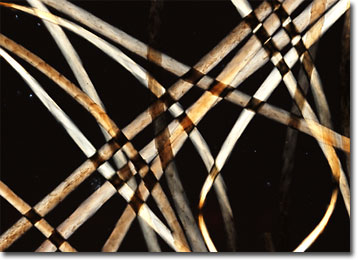Polarized Light Microscopy Digital Image Gallery
Alaskan Seal Hair
The Pribilofs are a small cluster of Alaskan islands located in the Bering Sea that are perhaps better known as the Fur Seal Islands. Covering an area of about 75 square miles, the islands comprise the largest fur seal haven in the world.

View a second image of Alaskan Seal Hair
The Fur Seal Islands, which act as a breeding ground for the many northern fur seals that visit them each year from April to November, have been the subject of significant controversy over the years. With the purchase of Alaska in 1867, official possession of the islands transferred from Russia to the United States. However, many nations continued sealing operations in the surrounding waters of the North Pacific, greatly affecting the fur seal populations of the islands. At one point, the United States began seizing vessels that were caught sealing near the islands, but eventually halted this practice when a tribunal ruled against such actions. Since that time, various conservation treaties have been established, though they have been broken at times. Nevertheless, in the second half of the 1900s, the international agreements seemed to have garnered a certain amount of success as the numbers of fur seals inhabiting the area rose significantly. Some evidence suggests, however, that in recent years they have again begun to decline.
Fur seals, as their name implies, are highly valued for their pelts, which exhibit a dense, waterproof underfur that typically consists of more than 350,000 hairs per square inch. Several different species of fur seal have been classified, all of which are members of the family Otariidae, which is comprised of the eared seals. Most fur seal species inhabit the southern hemisphere, but the northern fur seal is the variety that migrates each year to the islands of Alaska. This sociable and notably vocal variety of seal possesses hind flippers that can rotate forward, enabling them to move sufficiently well on dry land. Weighing as much as 600 pounds, males are considerably larger than females, which typically weigh about 100 pounds. The fur of the animals varies somewhat, but generally appears black when wet and brown when dry.
